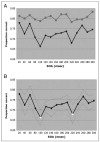Two phases of V1 activity for visual recognition of natural images
- PMID: 19413482
- PMCID: PMC3369215
- DOI: 10.1162/jocn.2009.21253
Two phases of V1 activity for visual recognition of natural images
Abstract
Present theories of visual recognition emphasize the role of interactive processing across populations of neurons within a given network, but the nature of these interactions remains unresolved. In particular, data describing the sufficiency of feedforward algorithms for conscious vision and studies revealing the functional relevance of feedback connections to the striate cortex seem to offer contradictory accounts of visual information processing. TMS is a good method to experimentally address this issue, given its excellent temporal resolution and its capacity to establish causal relations between brain function and behavior. We studied 20 healthy volunteers in a visual recognition task. Subjects were briefly presented with images of animals (birds or mammals) in natural scenes and were asked to indicate the animal category. MRI-guided stereotaxic single TMS pulses were used to transiently disrupt striate cortex function at different times after image onset (SOA). Visual recognition was significantly impaired when TMS was applied over the occipital pole at SOAs of 100 and 220 msec. The first interval has consistently been described in previous TMS studies and is explained as the interruption of the feedforward volley of activity. Given the late latency and discrete nature of the second peak, we hypothesize that it represents the disruption of a feedback projection to V1, probably from other areas in the visual network. These results provide causal evidence for the necessity of recurrent interactive processing, through feedforward and feedback connections, in visual recognition of natural complex images.
Figures


References
-
- Amassian VE, Cracco RQ, Maccabee PJ, Cracco JB, Rudell A, Eberle L. Suppression of visual perception by magnetic coil stimulation of human occipital cortex. Electroencephalography and Clinical Neurophysiology. 1989;74:458–462. - PubMed
-
- Beckers G, Homberg V. Impairment of visual perception and visual short term memory scanning by transcranial magnetic stimulation of occipital cortex. Experimental Brain Research. 1991;87:421–432. - PubMed
-
- Benjamini Y, Hochberg Y. Correcting the false discovery rate—A practical and powerful approach to multiple testing. Philosophical Transactions of the Royal Society of London, Series B, Biological Sciences. 1995;57:289–300.
-
- Bonmassar G, Schwartz DP, Liu AK, Kwong KK, Dale AM, Belliveau JW. Spatiotemporal brain imaging of visual-evoked activity using interleaved EEG and fMRI recordings. Neuroimage. 2001;13:1035–1043. - PubMed
-
- Bullier J. Cortical connections and functional interactions between visual cortical areas. In: Fahle M, editor. Neuropsychology of vision. Oxford University Press; Oxford: 2001a.
Publication types
MeSH terms
Grants and funding
LinkOut - more resources
Full Text Sources
Other Literature Sources

